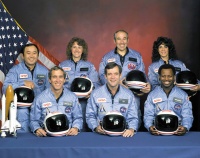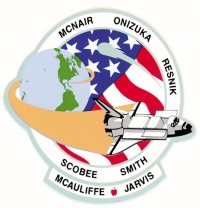STS-51L
From The Space Library
 | |
| Organization | NASA-Office of Space Science Applications (United States), NASA-Office of Space Flight (United States) |
|---|---|
| Mission type | Astronomy,Engineering, Human Crew |
| Launch date | January 28, 1986 |
| Launch vehicle | Space Shuttle |
| Launch site | Cape Canaveral, United States |
| COSPAR ID | CHALNGR |
| Inclination | 28.45 degrees |
| Experiments | Here |
| Alternate Names | STS 25, STS 51L, Spartan Halley,TDRS-B |
| Additional Information | Here |
| PDMP Information | Here |
| Data Collection | Here |
| Payload Mass Up | 23726.51 kg |
| Payload Mass Down | kg |
| Orbiter | Challenger |
| Lift Off Mass | 2,057,537.73 kg |
| Orbiter Weight at Liftoff | 122,195.00 kg |
| Orbiter Weight at Landing | kg |
Contents |
[edit] Crew
- Commander: Francis R. Scobee
- Pilot: Michael J. Smith
- Payload Commander:
- Mission Specialist 1: Ellison S. Onizuka
- Mission Specialist 2: Judith A. Resnik
- Mission Specialist 3: Ronald E. McNair
- Mission Specialist 4:
- Mission Specialist 5:
- Payload Specialist 1: Gregory Jarvis (Hughes)
- Payload Specialist 2: Sharon Christa McAuliffe, Teacher In Space
ISS/Mir Crew Transport
[edit] Mission
This mission, one of the continuing STS series, carried a Tracking and Data Relay Satellite (TDRS-B) to be launched from the cargo bay, and the experiment Spartan Halley. The spacecraft exploded January 28, 1986, at high altitude over the Atlantic Ocean during the launch phase, and all crew members were lost. Because the spacecraft did not reach orbit, no International ID was assigned. After this mission, further STS flights were postponed until investigation and remedial actions could be completed. The next STS flight was STS 26 on Sept. 29, 1988, which also reverted to the sequential series numbering used originally, rather than the numbering scheme that used planned launch year and serial letter. Within this series, STS 25 would correspond to the failed Challenger mission.
[edit] EVA
[edit] Payload
Tracking Data Relay Satellite (TDRS)-B; SPARTAN-203 Halley's Comet Experiment; Teacher in Space Project; Fluid Dynamics Experiment; Comet Halley Active Monitoring Program; Phase Partitioning Experiment (PPE); Radiation Monitoring Experiment (RME); three Shuttle Student Involvement Program experiments Loss of vehicle and crew during launch, 11:39 a.m. EST
[edit] Books about the Space Shuttle Program
Buy This Book Click here |
Buy This Book here |
Buy This Book Click here |
Buy This Book Click here |





